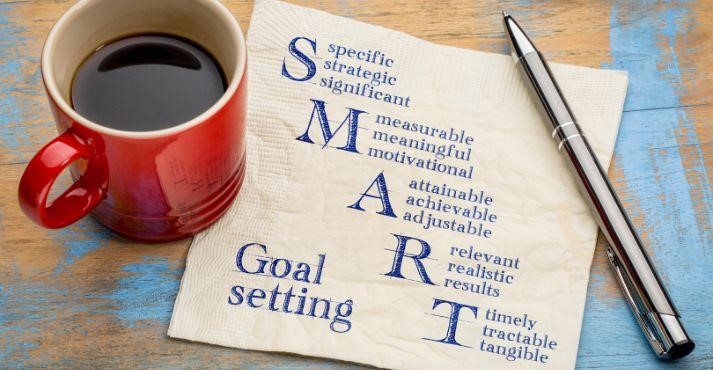The trade show game is leveling up – and you need a strategic plan to succeed.
With trade shows becoming an excellent platform for the hospitality industry, you need to set clear trade show goals in 2024 to stand out. Goals will help you set the roadmap and accomplish results for your hospitality business.
So, how do you set your targets?
Tips for Setting Your Tradeshow Goals
Whether you are a first-time exhibitor or an experienced participant, you must set trade show goals.
Let’s explore the top 10 tips for setting your tradeshow objectives.
1. Reflecting on Past Performance:
Take a moment to reflect on past trade shows. Did you accomplish your targets, like boosting your brand or grabbing leads? Think about what went well and what needs work for the next one.
Based on your reflections, create an action plan outlining specific steps for improvement in areas where you identified weaknesses or opportunities.
Here’s how you can analyze your past performance:
- Collect Data and Metrics: Gather quantitative data such as the number of leads generated, sales made, and attendance.
- Review Objectives: Revisit the objectives you set before the trade show. Evaluate whether you achieved them and if they were realistic and aligned with your overall business goals.
- Attendee Feedback: Collect feedback from attendees verbally and through surveys. Understand their experiences, what they liked, and areas where improvements can be made.
- Financial Analysis: Conduct a thorough financial analysis of the event. Compare the budget to the actual expenses and revenue generated.
- Assess Marketing and Promotion: Evaluate the effectiveness of your pre-event hospitality marketing and promotional efforts. Assess which channels worked well and which ones need improvement for future events.
- Engagement and Interactions: Review the engagement and interactions at your booth. Assess the effectiveness of your staff in engaging with attendees and conveying your message.
- Competitor Analysis: Analyze the activities and strategies of your competitors during the trade show. Understand what worked for them and whether there are opportunities to adopt similar strategies.
- Technology and Tools: Evaluate the technology and tools used during the trade show, such as interactive displays, lead capture systems, or virtual components. Determine if they were effective and if there are better alternatives.
- Logistical Assessment: Assess the logistics of your booth setup, location, and overall event organization. Identify any challenges or successes related to logistics.
- Team Debrief: Conduct a debrief with your team to gather their perspectives. Discuss what worked well, what could be improved, and any lessons learned for future events.
Analyze the impact of your trade show and how it helped your hospitality business improve and scale. Past performance is the best place to learn, reflect, and prepare for the following trade shows.
2. Aligning with Business Objectives
Linking your trade show goals with your overall hotel business plan is like ensuring all the puzzle pieces fit just right. When your trade show goals match up with your more prominent business plans, it’s not just about how well you do at the trade show – it’s about boosting your whole business.
Think about your goals – are you trying to sell more, build up your brand, or keep up with the market hype? If your business objective is to expand reach in new markets, you need to set goals for brand awareness in new markets.
When all these objectives align, the outcome resembles a collaborative effort that brings satisfaction to all involved.
3. Setting SMART Goals

A successful trade show process starts with setting SMART goals – Specific, Measurable, Achievable, Relevant, and Time-bound. Think of it like mapping out a clear path for your trade show strategy.
Setting goals is like using a GPS for your efforts – it shows you where you want to go. Make them measurable so you can easily track progress.
Keep goals achievable, like hitting a target you can reach. Please ensure they’re relevant to your overall trade show plan; otherwise, you might go off course. Lastly, add a deadline for urgency.
When setting trade show objectives, be crystal clear.
For example:
- Specific: Increase online customer reviews by 20% within the next six months by improving guest experience satisfaction scores, responding promptly to feedback, and implementing targeted service enhancements.
- Measurable: Achieve an average review rating of 4.5 out of 5 on major online review platforms (such as TripAdvisor, Google, and Yelp) within the next quarter, as measured by the cumulative scores from guest reviews.
- Achievable: Implement a guest feedback management system to promptly address customer concerns and ensure staff is trained to enhance customer loyalty and satisfaction. Conduct regular training sessions to equip employees with the necessary skills to exceed guest expectations.
- Relevant: Enhance the hotel’s online reputation and brand image, ultimately driving an increase in bookings and revenue. This aligns with the broader business strategy of positioning the hotel as a top choice for guests seeking exceptional service and accommodations.
- Time-Bound: Achieve a 20% increase in online customer reviews within the next six months with monthly progress tracking. Regularly assess performance metrics and adjust strategies to stay on track and meet the target goal by the established deadline.
4. Prioritizing Goals
Think of trade show goals like sorting through your to-do list – it’s about focusing on what matters. Align your trade show plan with your business priorities, focusing on what’s crucial for success.
When you set goals, consider your unique business needs. Do you want to boost sales, make new connections, or stand out at top food service trade shows? Your goals should be tailored and focused.
Whether showing off new products, meeting with industry leaders, or getting your brand out there, ensure your goals point to what matters for your business.
5. Quantity vs. Quality
Balancing between the quantity of leads and the quality of connections is a critical consideration for exhibitors at trade shows.
While acquiring a large volume of leads may seem enticing, it’s equally important to prioritize cultivating meaningful relationships that can lead to long-term partnerships and loyal customers.
Setting trade show goals prioritizing meaningful engagement and relationships entails a shift from merely collecting contacts to fostering genuine connections. Exhibitors should focus on:
- Targeted Approach: Concentrate efforts on attracting attendees who align with the ideal customer profile, ensuring that each lead has genuine potential.
- Qualification Criteria: Establish clear criteria for qualifying leads based on factors such as fit with the product or service, interest level, and conversion likelihood.
- Interactive Engagement: Prioritize interactive activities and personalized interactions that encourage attendees to actively engage with the brand and develop a deeper understanding of its offerings.
- Follow-Up Strategy: Develop a robust follow-up strategy emphasizing nurturing relationships beyond the event, providing value and support to leads as they progress through the sales funnel.
By striking a balance between quantity and quality, exhibitors can maximize the effectiveness of their trade show efforts, ultimately driving meaningful connections and sustainable business growth.
With this in mind, crafting goals that guarantee meaningful engagement becomes essential—think of it as sowing seeds for future success. Instead of chasing every opportunity, focus on specific objectives.
6. Brand Visibility and Positioning

Elevating your brand visibility and positioning at a trade show is like putting your business in front of your potential customers. Craft your trade show strategy to shine a light on your brand, ensuring it stands out amidst the crowd.
Strategizing goals related to enhancing brand awareness during a trade show involves careful planning and consideration of various factors. Here’s how you can strategize effectively:
- Define Objectives: Begin by clearly defining your goals for brand awareness at the trade show. Determine what specific outcomes you aim to achieve, such as increasing brand recognition, generating leads, or introducing new products.
- Know Your Audience: Understand the demographics and preferences of the attendees expected at the trade show. Tailor your brand messaging and promotional activities to resonate with this audience effectively.
- Create a Compelling Booth: Design an attractive booth that reflects your brand identity and captures the attention of passersby. Incorporate vibrant colors, bold graphics, and interactive displays to draw visitors in.
- Utilize Marketing Materials: Prepare marketing materials such as brochures, flyers, and promotional items that showcase your brand and offerings. Ensure these materials are visually appealing and informative.
- Engage Attendees: Plan engaging activities or demonstrations within your booth to encourage interaction with attendees. This could include product demos, contests, or interactive experiences that leave a memorable impression.
- Leverage Social Media: Use social media channels to generate buzz about your participation in the trade show. Share sneak peeks, behind-the-scenes content, and announcements to attract attendees to your booth.
- Network with Industry Peers: Use networking opportunities to connect with other exhibitors, industry influencers, and potential partners. Building relationships within the industry can further enhance your brand’s visibility.
By strategizing goals related to enhancing brand awareness in these ways, you can maximize your impact at the trade show and leave a lasting impression on attendees.
At trade shows, setting goals that boost your brand’s visibility is crucial. Start by strategizing ways to make your brand stand out amidst the crowd.
- Consider eye-catching booth designs, engaging signage, and interactive displays to attract attendees’ attention.
- Additionally, focus on effective brand positioning on the trade show floor.
- Choose a prime location that ensures maximum exposure to foot traffic.
- Utilize clear messaging and visuals that concisely convey your brand identity and value proposition.
- Engage with visitors through friendly interactions and demonstrations to leave a lasting impression.
Remember, the goal is to be seen and remembered positively by potential customers and industry peers. By implementing these strategies, you can effectively enhance your brand’s visibility and positioning at trade shows, ultimately driving greater awareness and interest in your products or services.
7. Engagement and Interactivity
To dominate the trade show scene, turn your booth into an exciting experience. When setting goals, consider getting attendees involved – imagine your stall as an activity hub attracting visitors. Keep it simple yet impactful.
Here are some essential tips to drive engagement and interactivity at trade shows:
- Create visually appealing and interactive booth designs to attract attention.
- Offer hands-on product demonstrations to engage attendees directly.
- Incorporate interactive technologies like touchscreens or VR experiences.
- Host contests or giveaways to encourage participation and excitement.
- Utilize social media to create buzz and promote real-time engagement.
- Implement gamification elements to make the experience more enjoyable.
- Provide live presentations or workshops to share valuable insights.
- Facilitate networking opportunities to encourage attendee interaction.
- Use QR codes for easy access to digital content and promotions.
- Foster one-on-one conversations with knowledgeable booth staff.
- Leverage interactive surveys or polls to gather attendee feedback.
- Incorporate elements of surprise or novelty to capture attention.
- Encourage user-generated content through photo booths or social media challenges.
- Collaborate with influencers or industry experts to enhance credibility.
Strategies for an engaging booth environment are like designing an inviting playground. Incorporate interactive elements like product demonstrations, games, or interactive displays. This boosts trade show performance and turns your booth into a destination attendees will want to attend. Let’s take a look:
- Interactive Product Demonstrations: Showcase your products or services in action to engage attendees and demonstrate their value firsthand.
- Interactive Games: Incorporate fun and interactive games or challenges that encourage participation and create a memorable experience for visitors.
- Virtual Reality or Augmented Reality Experiences: Offer immersive experiences using VR or AR technology to captivate attendees and leave a lasting impression.
- Live Presentations or Workshops: Host live presentations or workshops on topics relevant to your industry or offerings to educate and entertain attendees.
- Photo Booth or Selfie Stations: Set up a photo booth or selfie station with props related to your brand or products, encouraging attendees to share their experiences on social media.
- Contests or Giveaways: Organize contests or giveaways with enticing prizes to attract visitors to your booth and encourage engagement with your brand.
8. Lead Generation and Conversion:
Regarding trade shows, have clear goals for getting and converting leads. It’s like having a plan to find and turn potential customers into actual ones.
Set trade show objectives to generate leads. Use activities, presentations, or networking to grab the attention of possible clients. It’s about starting connections that can grow into valuable relationships. Let’s list down the steps for the lead generation process:
- Set Specific Lead Generation Goals: Define clear objectives for acquiring leads during the trade show, such as the number of leads to be collected or the desired quality of leads.
- Utilize Targeted Marketing: Employ targeted marketing tactics to attract potential leads to your booth, including personalized email campaigns, social media advertising, and targeted promotions.
- Engage Attendees Actively: Implement strategies to actively engage with attendees, such as offering product demonstrations, hosting interactive activities, or providing valuable educational content.
- Capture and Qualify Leads: Utilize lead capture tools and techniques to collect contact information and qualify leads based on their level of interest and fit with your offerings.
- Follow-up Promptly: Develop a follow-up plan to nurture leads after the trade show, including personalized follow-up emails, phone calls, or meetings to continue the conversation and move leads through the conversion process.
- Track and Analyze Results: Monitor and analyze the effectiveness of your lead generation strategies, adjusting your approach as needed to optimize results and improve ROI.
To convert leads, follow a plan. Send timely messages, talk personally, and offer special deals. It’s like guiding potential customers from being interested to becoming long-term partners. Following are some techniques that you can employ:
- Personalized Communication: Tailor messages to each lead’s needs and interests.
- Value Provision: Offer resources, advice, and promotions to engage leads.
- Trust Building: Showcase testimonials, case studies, and awards to establish credibility.
- Clear Call-to-Action: Provide straightforward next steps for leads to follow.
- Streamlined Sales Process: Simplify forms and steps to minimize friction in the conversion journey.
By sticking to straightforward trade show goals for lead generation and conversion, you ensure a solid path for business opportunities and growth.
9. Post-Event Evaluation

Even at the end of the trade show, remember it’s not over. Evaluating is essential for exhibitors as it helps them figure out what worked and what didn’t and how to tweak goals for the next round.
Post-event evaluation is crucial for exhibitors to gauge the success of their participation and make informed decisions for future endeavors.
By assessing goal achievement and performance, exhibitors can identify strengths, areas for improvement, and strategic adjustments to enhance their outcomes in subsequent events.
- Importance of Evaluation: Emphasize the significance of evaluating goal achievement post-event to measure return on investment (ROI), identify successes, and pinpoint areas needing refinement.
Steps for Assessment:
- Review Goals: Reflect on initial objectives set for the event and determine the extent to which they were met.
- Analyze Metrics: Scrutinize quantitative data such as leads generated, sales made, and attendee engagement metrics.
- Seek Feedback: Gather qualitative feedback from team members, attendees, and other stakeholders to gain insights into the event’s impact.
- Assess ROI: Calculate the ROI by comparing expenses incurred against the benefits derived from the event.
- Identify Lessons Learned: Identify successes, challenges, and lessons learned to inform future decision-making.
- Adjust Goals: Based on the evaluation findings, refine goals for future events, considering insights gleaned and strategic adjustments needed to optimize outcomes.
Exhibitors can enhance their event strategies, maximize ROI, and drive continued success in their exhibition efforts by conducting a thorough post-event evaluation and adjusting trade show goals accordingly.
10. Adapting Goals Throughout the Year
Remaining flexible and adjusting trade show goals is like steering a ship through changing waters. Encouraging exhibitors to stay adaptable ensures they can navigate business needs effectively.
Business sectors evolve, and so should trade show goals. It’s crucial to reassess regularly and change objectives based on how the market shifts. Think of it as adjusting your sails to catch the best wind for yourself.
Continuous improvement in trade show strategies is the key. Use those insights to refine your goals as you learn from each event. It would be best to focus more on certain aspects or try new tactics. It’s about staying flexible and responsive to what works best for your business.
By embracing adaptability and making adjustments, exhibitors can optimize their trade show goals to align effortlessly with the ever-changing business environment. It’s not about a rigid plan but a dynamic approach ensuring sustained business success.
Conclusion
When participating in a trade show, clear trade show goals act like a guiding roadmap for exhibitors. They shape strategies, from boosting brand visibility to catching meaningful leads.
Looking back, setting SMART objectives, and prioritizing based on business needs keep things focused. Balancing quantity, quality, and engaging strategies turns a booth into a lively space.
After the event, evaluating is a crucial checkpoint, encouraging improvement. Staying adaptable ensures that goals match evolving business needs. Trade show goals aren’t just targets; they’re the scope leading exhibitors to achieve success in the competitive trade show arena.








